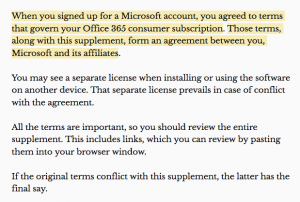 Let’s be clear. Those “Terms and Conditions” we have to “accept” or “agree to” before using new software, phones and other technology are anything but clear.
Let’s be clear. Those “Terms and Conditions” we have to “accept” or “agree to” before using new software, phones and other technology are anything but clear.
I blame lawyers, who stuff sentences with words to cover every possible situation. The sentences are wordy and repetitive. And the lawyers seem to think shouty all-caps lettering IS THE BEST WAY TO EMPHASIZE A POINT.
Instead, we need plain language. That means the words, the structure and the design “are so clear that the intended audience can easily find what they need, understand what they find, and use that information.” So says PLAIN, Plain Language Association InterNational, founded by plain language crusaders Cheryl Stephens and Kate Harrison Whiteside.
To mark International Plain Language Day on October 13, I thought it would be fun to look at some typical terms and conditions. Here’s a sample of some of the wording to renew Microsoft Office 365, as judged by the Hemingway app:
Plain language includes avoiding jargon. Sticking with the simplest words that convey your meaning. Using short sentences and paragraphs.
This section begins with a 79-word sentence, which is alarming in itself. (For ease of reading, an average of 15 to 20 words is better.) The app points out that each of the highlighted sentences is “so dense and complicated that your readers will get lost trying to follow its meandering, splitting logic.” There’s lots of Random Capitalization. The passage mentions Supplement and Agreement five times each, and maybe one word can replace the other; hard to say. The passage is considered to be a post-graduate level and is rated “poor.”
I tried simplifying the Microsoft terms, cutting the word count by about a third and splitting up the dense block of type:
I had to guess at some of the meaning; the yellow warns of lengthy, complex sentences; and no doubt the lawyers would have a fit. But the revision is given a level of Grade 8 and earns a rating of “good.” It certainly has a better chance of being read and understood than the original.
If only more Terms and Conditions were written in plain language, we might actually read them before clicking Agree. Agree?
Image: Rainy window from Pixabay.


